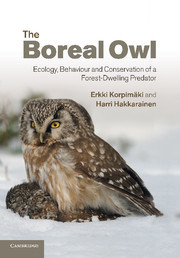Description
The Boreal Owl
Ecology, Behaviour and Conservation of a Forest-Dwelling Predator
Authors: Korpimäki Erkki, Hakkarainen Harri
A study of the Boreal Owl's hunting modes, habitats prey interactions, reproduction, dispersal, survival and mortality, population regulation and conservation.
Language: English
Subject for The Boreal Owl:
Approximative price 63.71 €
In Print (Delivery period: 14 days).
Add to cart
The Boreal Owl
Publication date: 07-2014
Support: Print on demand
Publication date: 07-2014
Support: Print on demand
Approximative price 149.32 €
In Print (Delivery period: 14 days).
Add to cart
The boreal owl: ecology, behaviour and conservation of a forest-dwelling predator
Publication date: 09-2012
408 p. · 17x24.4 cm · Hardback
Publication date: 09-2012
408 p. · 17x24.4 cm · Hardback
Description
/li>Contents
/li>Biography
/li>
Widespread in North American forest regions including the Rocky Mountains, the Boreal Owl (Aegolius funereus) was once the most numerous predatory bird in Eurasian boreal forests. Synthesising the results of unique long-term studies of Boreal Owls, this book explores hunting modes, habitats and foods, prey interactions, mating and parental care, reproduction, dispersal, survival and mortality, population regulation and conservation in boreal forests. Providing a detailed introduction to the species, the authors study the complex interactions of Boreal Owls with their prey species. They examine the inter-sexual tug-of-war over parental care, and the behavioural and demographic adaptations to environmental conditions that predictably and markedly fluctuate both seasonally and multi-annually. They also question whether Boreal Owls are able to time their reproductive effort to maximise lifetime reproductive success. Discussing the effect of modern forestry practices on owl populations, the book also examines how Boreal Owls could be managed to sustain viable populations.
Preface; Acknowledgements; 1. Introduction; 2. Boreal (or Tengmalm's) Owls: briefly; 3. Study areas and research methods; 4. Habitat use, roosts and nest sites; 5. Interactions with prey animals; 6. Life-history; 7. Mating and parental care; 8. Reproduction; 9. Dispersal and autumn movements; 10. Survival and mortality under temporally varying food conditions; 11. Old forests increase survival and lifetime reproductive success; 12. Family planning under fluctuating food conditions; 13. Population dynamics; 14. Population regulation; 15. Conservation of Boreal Owl populations; References; Index.
Erkki Korpimäki is Professor of Animal Ecology at the Department of Biology, University of Turku, Finland. His long-term research questions have focused on how predators are adapted to the large spatio-temporal fluctuations in their main prey densities, the apparent impacts of predators on prey populations and the effects of human-induced changes in the environment on viability of populations.
Harri Hakkarainen is Adjunct Professor of Animal Ecology at the Department of Biology, University of Turku, Finland. His main fields of research have included landscape ecology, environmental ecology, life-history and demography, habitat and diet selection, sexual selection and dispersal of individuals.
Harri Hakkarainen is Adjunct Professor of Animal Ecology at the Department of Biology, University of Turku, Finland. His main fields of research have included landscape ecology, environmental ecology, life-history and demography, habitat and diet selection, sexual selection and dispersal of individuals.
© 2024 LAVOISIER S.A.S.




